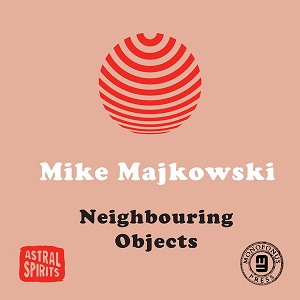 Turn off the mechanical, logic-soaked part of your brain and sympathetic resonance sounds like a magic trick, and looks like one too. It’s the phenomenon that explains why opera singers can shatter glass from across the room with nothing but their voice. Whether bright or ominous, the spontaneous ring (or explosion) of an untouched body or an unplayed string is provocative. It is a sign of sound’s invisible inner life, the one that has nothing to do with intentions or compositions, the one that John Cage implied when he suggested that writing music was a means of "waking up to the very life we’re living, which is so excellent once one gets one’s mind and one’s desires out of its way and lets it act of its own accord." That is the sort of life Mike Majkowski is after on Neighbouring Objects, his latest cassette on Astral Spirits. The title suggests sympathetic resonance abstractly, but it also describes Majkowski’s instrumentation, which for the first time includes bass guitar, accordion, piano, and percussion alongside the core of his double bass. Magical though it may seem, Majkowski uses these tools to emphasize both the affective and the measurable, more physical properties of sound.
Turn off the mechanical, logic-soaked part of your brain and sympathetic resonance sounds like a magic trick, and looks like one too. It’s the phenomenon that explains why opera singers can shatter glass from across the room with nothing but their voice. Whether bright or ominous, the spontaneous ring (or explosion) of an untouched body or an unplayed string is provocative. It is a sign of sound’s invisible inner life, the one that has nothing to do with intentions or compositions, the one that John Cage implied when he suggested that writing music was a means of "waking up to the very life we’re living, which is so excellent once one gets one’s mind and one’s desires out of its way and lets it act of its own accord." That is the sort of life Mike Majkowski is after on Neighbouring Objects, his latest cassette on Astral Spirits. The title suggests sympathetic resonance abstractly, but it also describes Majkowski’s instrumentation, which for the first time includes bass guitar, accordion, piano, and percussion alongside the core of his double bass. Magical though it may seem, Majkowski uses these tools to emphasize both the affective and the measurable, more physical properties of sound.
Even before it begins, "Chandelier/Gondola/Echoing Stars" makes the curious suggestion that a decorative light fixture, a Venetian mode of transportation, and several distant balls of plasma might have something in common, or might be, in some way, neighbors. Finding precise musical analogues for these objects is beside the point, but the piece is arranged into three parts, and those parts echo one another. The first one is populated by a tremulous drone that hums like an industrial saw in an empty warehouse. The sound is acoustic and fricative, filled with fluctuations and disturbances that highlight the space the sound is resonating in almost more than the sound itself. Taken together the source and the space produce a rough harmony that flashes and wanes like a candle.
The second section contains a higher pitched noise generated by a bow and strings, the grind and scrape of horsehair replacing the whir of the buzzsaw. The bowing is quick and sharp and, again, distinct from the accompanying tones that float around it. Here the relationship between the two components is more clearly established. As Majkowski moves up and down the neck of his concert bass, the ringing tones follow suit. This resolves suddenly into the final section, which combines elements from the first two with a melody played on electric bass and chimes. Those chimes twinkle like stars against the darker pulse of the drones and signal the completion of the song’s upward trajectory. Whatever the status of the objects in the title, all of Majkowski’s instruments finally line up, from the lowest register to the highest, in a kind of harmonic syzygy.
On the second side, "Carnival of Decay" utilizes similar techniques to render a more dramatic effect. Majkowski begins by interlacing his double bass and bass guitar. They swell and recede alternately, then merge into a single throbbing tone as a piano, an accordion, and a set of rattles enter the mix. After the accordion wheezes its last wheeze, the sound of Majkowski’s bow also disappears, leaving only a hollow murmur. A single note, which matches that murmur perfectly, is played on the piano over and over while a small host of squeaky toys chirp away like laughter. Sympathetic resonance anchors this piece too, but this time, instead of holding the different instruments together, the anchor drags the music down into the depths, where something sinister is apparently waiting. If the inner life of the instruments is the subject of side A, then side B showcases the inner life of the attentive mind, which resonates sympathetically with both the dreariest and most luminous of musical phenomena.
samples:
 
Read More

